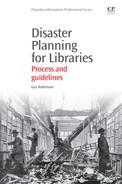A note on terminology
In this book, I have used ‘risk’ in the singular as an all-encompassing term for risk in general. Depending on the context, the term can also indicate a single and specific threat such as fire, flooding or theft. Synonymous with risk in the latter usage are ‘danger’, ‘peril’ and ‘threat’.
For purposes of simplicity and clarity, I have used the term ‘disaster planning’ throughout. In the general field, this activity is also referred to as ‘business continuity [or resumption, or recovery] planning’, ‘contingency planning’ and ‘emergency [response, or management] planning’. While I have misgivings about the sound and sense of ‘disaster planning’, I defer to common usage since most readers will be familiar with it.
Disaster planning comprises a series of procedures, plans and programmes that enable organizations to prepare for, respond to and recover from negative events of all kinds. For libraries and other information organizations, the author’s recommended classification of such events is as follows:
All of the above-mentioned terms have been used in different ways by other authors, organizations, professions and industries. I trust that readers will find my usage helpful, even though they may prefer different terms.
